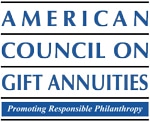 The American Council on Gift Annuities announced last week that its suggested rates for Charitable Gift Annuities, or CGAs, would remain unchanged from last year. Here’s a look at the assumptions that lead to the rates.
The American Council on Gift Annuities announced last week that its suggested rates for Charitable Gift Annuities, or CGAs, would remain unchanged from last year. Here’s a look at the assumptions that lead to the rates.
The Council meets at least annually to review its rate recommendations and consider adjustments to its assumptions.
Clients often ask where the rates that 95% of charities rely on, come from. They come from five assumptions.
1. Your charity will realize 50% of the face value of each gift. At the death of the one or two people receiving income from a CGA (the annuitant/s), what remains from the face value of the gift is transferred to your charity. If it’s a $25,000 gift annuity, you should get $12,500. For that to happen, the other assumptions have to hold. What’s your experience been?
(The annuitants are usually the donors, but not always. Think of a donor couple arranging for an adult child to receive payments for life.)
2. Annuitants will comply with mortality assumptions. I know people who I hope long outlive their projected mortality. There are a few others who are welcome to go at any time.
ACGA uses the Annuity 2000 Mortality Tables. (Click the link to see how long the National Association of Insurance Commissioners says you’ll live.) There are two tables, for male and female. To be conservative, ACGA assumes all annuitants are female (live longer) and one year younger than their real age (so they’ll get a lower rate of payment).
Mortality is a complex subject. It’s based on large numbers and doesn’t apply to individuals, so if you don’t like what you see in the table above, there’s still considerable hope for you. But, for gift annuities to work there has to be an assumption around each annuitant’s life expectancy, and mortality tables are the best we’ve got.
3. Your charity will pay administrative fees of 1%. That’s taken as a percentage of your gift annuity reserve fund, which many states require. My clients are small- and mid-size charities. For their gift annuity programs 1% is wildly low. Five to 8% is more what I see.
What’s your experience?
4. The reserve fund will earn 4.25% annually. The reserve fund has to be invested and the Council assumes you’ll earn 4.25% each year. That’s been highly unlikely for the past 3 to 4 years because all but the largest reserve funds are conservatively invested. Deduct fees from earnings and that’s your earnings net of expenses. For a lot of charities it’s a negative number recently.
What do you see?
5. Annuitants are paid quarterly. Payments can also be monthly, semi-annual or annual. Quarterly is most common in my experience. If payments are less frequent then your reserve fund will enjoy a higher balance as money remains in longer. Most charities allow donors to choose their payment frequency.
Those are the assumptions that translate into the Council’s suggested rates for immediate payment gift annuities. I haven’t covered deferred payment annuities.
A history lesson: in the mid-90’s there were two federal antitrust cases naming ACGA as defendant and alleging price-fixing in the rates. Congress twice stepped-in with laws to protect ACGA, gift annuities and all the charities (and others) that rely on the recommended rates. Check out this short summary of the legal drama.
I did not know the fees are that high among community foundations.
It’s important to recognize that fewer and fewer community foundations are willing to issue CGAs for other groups. Our community foundation clients now retain 25% or more of a matured CGA. Some are considering 40%. If the charity does not want to lose that much, the community foundation will often set up a managed fund for the charity using 100% of the residuum and retain the corpus.
A viable alternative for any non-profit is the outsourcing of your deferred gift administration. We recently did just that. By taking this action you are removing the burden of admin as well as the liability of each gift from your books. Most nonprofits do not have the staff required to take care of all the administration and financial management of a deferred gift program. Why assume the liability if you do not have to. Worth considering!
Thanks Tony
It is an annual expense, Ron. Take the example of a NY start-up program with the minimum required reserve of $100,000. The best fee I’ve seen for integrated administration and investment is $7,500.
The charity will often be asked in its application to justify its rates as actuarially sound and, perhaps, as sufficient to return a minimum percentage to the charity. The ACGA rates are widely recognized as sound by the states and are intended to return the 50% as I explained.
Question:
It is my understanding that if a charity chooses a higher rate than what the ACGA posts , then the Charity is subject to a higher compliance burden in that state. Is this true?
This is generally a good summary. One correction: the administrative expense assumption is 1% per year. The experience you see among your client charities of “Five to 8%” is probably not an annual expense.
Thanks, Lorri!
Great explanation Tony, and probably very much needed.